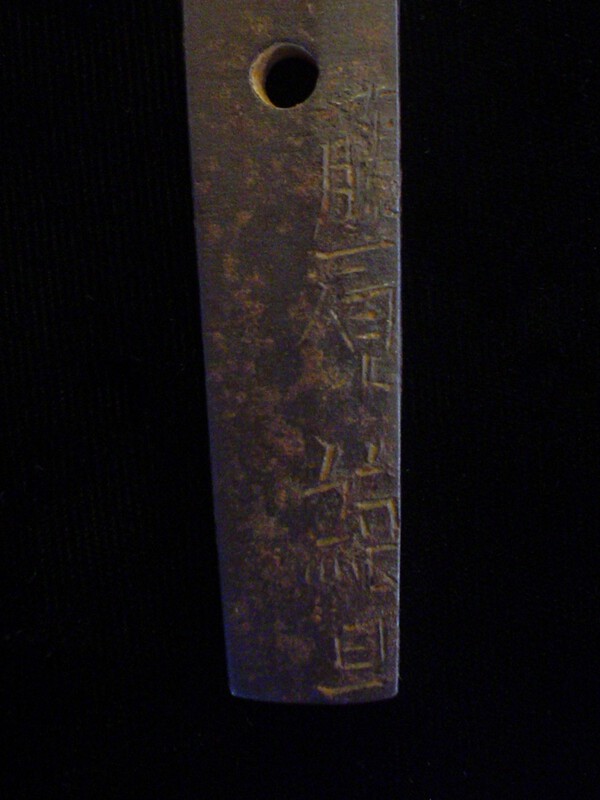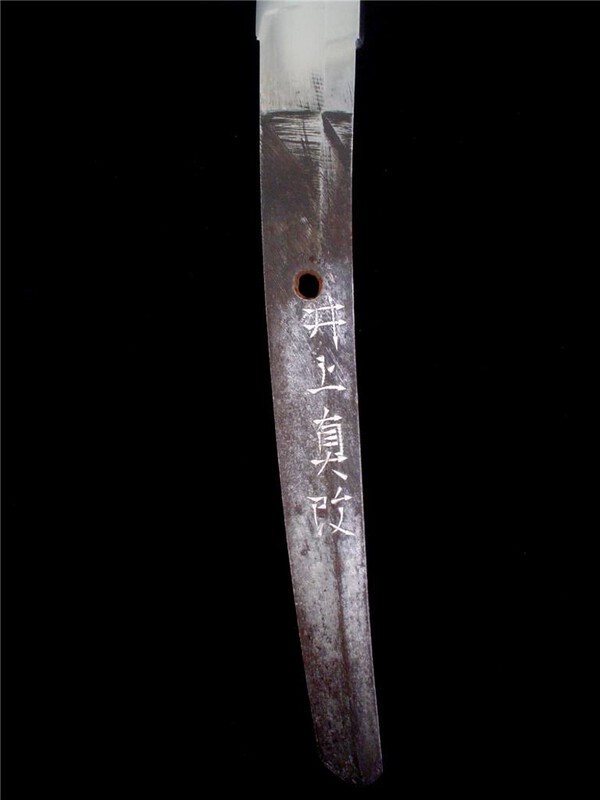-
Posts
124 -
Joined
-
Last visited
Content Type
Profiles
Forums
Events
Store
Downloads
Gallery
Everything posted by patrick7813
-
I did find the Munekage in Hawley’s. But, I’m still reading as (Fujiware) Shigekage. I’ll be the first to admit I struggle with these translations and could be wrong. I guess I'm stuck.................
-
This is what the Meikan indicates: "Taira Shigekage. Son of Shigetaka. Second generation. Around Genki (1570-73) Bungo province". I'm keying my assertion on the Genki reference.
-
This mei is Shigekage, Bungo province 1570-73 (see picture). Unfortunately, I can’t find any detailed information on this smith in sources I have. I’m told he is in the Meikan, which I don’t have. Any information relative to school, quality would be appreciated. Thanks.
-

Possible “Inouye Shinkai” gimei blade
patrick7813 replied to patrick7813's topic in Translation Assistance
Thanks George. I’ll pass the kamon information along to the current owner, who didn’t know. He also believes the blade was possibly presented as an honored gift, even though a gimei, but wasn’t certain. I’ll let him know there seems to be some consensus in that belief. The gunto koshirae is in mint condition. -

Possible “Inouye Shinkai” gimei blade
patrick7813 replied to patrick7813's topic in Translation Assistance
Thanks Chris. Enough said - I'll pass on it. -
I’m thinking of purchasing a gunto mounted sword with the blade signed (katana mei) as Inouye Shinkai (1673 – 1681). I suspect it’s a gimei because the patina/rust on the nakago doesn’t appear to date that old (see picture). There’s also a kamon on the kashira (not a normal “geometric design” one) and both menuki (see pics). I’m a little out of my depth here and am looking for opinions. Thanks in advance.
-

Ebay seller Showa22
patrick7813 replied to ww2collectors's topic in Auctions and Online Sales or Sellers
I have purchased from Yuzo (Showa22) 3-4 times spanning several years, the last about a year ago. The swords I kept were great. The one I returned was done without any difficulty. I did caution him on injudicious uses of terms like mint and excellent. His descriptions are starting points and he typically provides many detailed pictures. So review and ask questions. My experience is he’s very forthcoming with responses. -
Great collection Bill. I recently saw one sell for over $2500 and these appear in better condition! Cheers,
-
Yep, I get it. I don’t yet have any of those that merit a professional polish. I think we’re saying the same thing but you’re more artful. Cheers,
-
Chris No offense taken. I always appreciate your thoughts. Firstly, we're not talking about a collectable blade here (unless you're like me and collect Japanese military swords which likely aren't collectable in your definition). Secondly, I do understand the difference between a polish that Fred provides (and would only go that route on a Showato) versus a polish for a collectable blade (which I do not have). I'm also well aware of opinions that any quality Showato or Showa era Gendaito for that matter, with a tiny minority of exceptions, won't/don't qualify for the criteria of a collectable blade. Cheers,
-
Hi Grey Thanks for the input. I’m always torn about retaining the original wartime polish or not. I’d rate the original wartime polish on this blade as excellent +. I usually try and evaluate it by either (1) my desire to retain in my collection and therefore get it polished or (2) plan on parting with it later and therefore keep the original wartime polish. A collector friend has told me I’m too much a perfectionist to be a collector. Of course, if I get any polished that effectively eliminates parting with them because it’s nearly impossible to recoup that additional expense. Regardless, it’s not something I’ll run off and have done immediately. I’ll heavily ponder for some time. BTW, I’ve had 2 polished by Fred (one an Ikkansai Kunimori) and was very pleased with the outcome. Others agreed when seeing them “in hand” too. Cheers,
-
Guys Thanks to all. I’m feeling somewhat better now. I know I’ll (likely) be skewered for suggesting this but if I use one of the American based polishers (e.g., Fred Lohman; I’ve used his services before with very good results) for this Showato, will these issues distract from the finished product? It has a minor nail catcher nick in the Ha and I know that can be easily removed but don’t want any ware or shintetsu exposed in the Ji due to these “areas” (there are several) afterwards either. The shin gunto type 98 koshirae housing the blade is in mint condition so, to me, it's likely worth the investment. Cheers,
-
Thanks Chris. I was hoping that wouldn't be the situation. Cheers,
-
Guys OK, I’ll admit that I’m still learning and have alot to still learn. I have this Mano Masayasu forged blade (see picture) and I don’t know if what I’m seeing is the hada or evidence of delaminating (ware’)? I’ll gladly welcome all opinions. Thanks,
-
Chris These pictures don’t do the blade justice. When held "in hand" there is activity in the hamon but no hada. I'm unsure about oil vs water quenched. Maybe folded, forged, water quenched from western steel (haven't ruled out oil quenched yet). I believe this is likely a Showa blade but the use of a hitatsura temper is a head scratcher. Cheers,
-
-
-
Guys I recently encountered a blade with hitatsura temper that was mounted in a shin gunto koshirae. I’ve never encountered a “full” tempered blade let alone one in gunto mounts. I’ve found a reference to hitatsura being favored by smiths in the Soshu (Sagami) province during the Kamakura (no question this blade is much later than that era). This blade was forged by Kanetsura, a smith about which I’ve been unable to locate much documentation. My question is this: What is or was there a specific purpose of a hitatsura temper? It does seem to be “rare” in usage. Cheers and thanks,
-
Guys Thanks for all the feedback. This has been a teachable moment for me. I have a Kunimori gunto mounted blade with a midare hamon. Most of the others of his I've encountered or seen have a suguha hamon. Cheers,
-
There is a gunto mounted sword listed on eBay as by the Yasukuni Shrine smith Yasuhiro (nee Miyaguchi Shigeru), signed as Miyaguchi Yasuhiro, with the starting bid at $5K and a Buy-It-Now price of $7.5K http://www.ebay.com/itm/Japanese-SWORD- ... 2a2e2b89ba The description states the nakago is dated as “A lucky day in May 1945” (I did a quick scan and I think the kanji translates as that). My question is since Yasuhiro was no longer associated with the Shrine forge after 1936, how could a blade be forged and dated by him in 1945? I’m unaware of any examples where he used the mei of Miyaguchi Yasuhiro after leaving the Shrine (believe that was forbidden). The nakago appears suspiciously “new”. There are also odd tidbits in the description, for example, using an explanation of a Chinese flower, the Bellflower, for defining a kamon present on the kabuto-gane, that raise questions. I have no intention of bidding. I’m just curious. Opinions of what I’m actually seeing here (e.g., gimei, etc.)? Cheers,
-
I don’t believe the buyer is due a full refund. He did modify the item, even if only technically. It would be a defendable position for you that once he made that decision, the sword was his…….. and unless he takes the threading he removed from the tsuka cover to a lab and has it age tested, he can‘t prove it wasn’t period installed. If he wants a refund because the sword was not as advertised or a “flaw” not disclosed, that becomes murkier due to his modification. I’m sure once he got the sword “in-hand” and did whatever; he realized he significantly overbid (you won't see this bid level again) for what he received. By simply viewing pictures, it’s difficult to access an overall value. For a collector of militaria correctness, his modification would likely reduce any final sale value by 10-15 percent. Of course, in a future auction, you’ll have to disclose the tsuka cover had been removed. Due to that, you’d be better served to remove the tsuka and see if the smith signed/dated the nakago (tang) and then disclose that too. Unfortunately for you, if you don’t give him any refund and he disputes the sale to eBay for resolution, they usually side with the buyer. He’ll likely disagree with anything other than a full refund. If me, I’d proactively contact eBay and explain the situation to them before he lodges a dispute…..
-
Chris & George Thanks for all your insights and help. I appreciate it! I started this discussion with the idea of determining if a Showato with Yasuki steel in the mei would mean it has a higher worthiness than one without. Reading between the lines, the answer is likely. Certainly, some Showato are of a better quality than others. Whether a Showato made with Yasuki steel is better than one made from other steel (excepting Mikasa or Gunsui) solely due to the steel used can be debated due to lack of definitive information. Apparently, Kanesane was a regarded smith but how high I’m uncertain (no Mil. Yen rating) although he was awarded 2nd seat at the 41 Exhibition and betseki in 43 (Dr. Stein’s website has a detailed description). How that might play into his use of Yasuki steel (if at all) escapes me. He certainly forged blades without naming Yasuki steel in the mei. As an aside, I have a gunto mounted Koto era blade and therefore visual evidence of the superiority of a nihonto blade versus a showato blade. This discussion was never an attempt to compare the two. BTW, my searching shows the Mikasa was made in Great Brittan (Vickers, Barrow-in-Furness). I haven’t found any indication of the steel’s origin but I doubt Japan. I did find a statement that Japan in ca. 1900 lacked the technical capability to build a Dreadnaught. Cheers,
-
Guys Thanks for all the input – it certainly helps in my schooling. A final thought and this is from the military collecting perspective. If mentioning Yasuki, Misaka or Gunsui steel (or others) in the mei was a “marketing” technique, do you think it’s a safe assumption that Showato blades bearing those names were held in higher esteem that those not containing it? Cheers,
-
George, Thanks for your thoughts. I had not heard of blades being forged with Gunsui steel but will now familiarize myself as much as possible about it. I have heard of blades being forged from Mikasa steel (and the history associated with that steel) by very reputable smiths. There’s no doubt this Kanesane sword in question is a Showato. Given the feelings expressed about Yasuki steel, I still find it very “odd” that any reference that it was used to forge this blade is included in the mei. To me, that would imply some level of significance. Otherwise, why is it mentioned? Unfortunately, I suspect it’s another of these oddities about which we’ll never know the full story. Cheers,
-
Thanks. Interesting perspective but I understand it..... Cheers,












